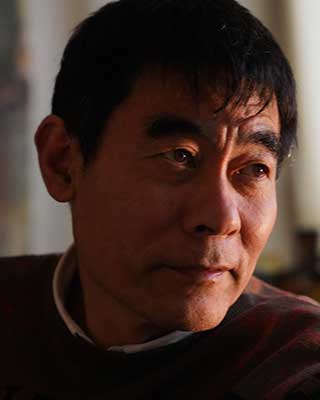The wide-screen immersive media experience, Ochre and Sky: Listening to the Land of Australia, explores the relationship between people and the land in Australia, from ancient times to today.
The film was created by filmmakers Alison Page and Nik Lachajczak of ZAKPAGE. The installation that accompanied it on tour is the work of Chinese–Australian artist Zhou Xiaoping.
The Ochre and Sky exhibition toured China from July 2023 to December 2024. The film is on show in the Great Southern Land gallery at the National Museum of Australia in Canberra.

We are all part of Country.
We are all connected to the sky, the water and the land.
The animals, the plants and the stories of place have been sung and written through time.
From the moment we are born, the echoes of past generations and the energy of elemental forces start to fill our beings with the essence of Country.
In the Australian Aboriginal world, that connection is maintained through family and ancestral memory, as it is for most people. But it is also invigorated through ceremony and ritual, and through loving Country as another member of our shared ancient family. Because when we care for Country – the water, the land and the animals – Country will care for us.

Traditionally, both First Nations and Chinese people have upheld strong family values. It is just one of many similarities between ancient First Nations and Chinese cultures, in addition to the use of Chinese herbal and First Nations bush medicines.
In this installation artwork artist Zhou Xiaoping uses rice as a medium to portray the significance of land, nature, life and love for family. Aboriginal art and culture are expressed through this favourite and familiar Chinese staple. Rice is also a favourite food of Aboriginal peoples.
Furthermore, the ochre strips on the rice symbolise land, and the relationship between life and the earth. For First Nations peoples, 'our land is our life’. Beyond these symbols, the work also creates a dialogue about the human soul and culture.
The use of rice as an artistic medium also conveys a cross-cultural message about the shared meanings that can be found in the accompaniments to everyday life.
Acknowledgements
A touring program from the National Museum of Australia
Supported by the National Foundation for Australia–China Relations

Ochre and Sky was on show at:
- Zhejiang Museum, Hangzhou, China, from 15 November to 29 December 2024
- Anhui Museum, Hefei, China, from 2 July to 1 September 2024
- Guangming Culture and Art Center, Shenzhen, China, 15 March to 12 May 2024
- Zhenjiang Museum, Zhenjiang, China, 1 January to 24 February 2024
- China World Art Museum, Beijing, China, 14 November to 17 December 2023
- Tianjin Art Museum, Tianjin, China, 18 July to 27 August 2023.
